Exploring Fair Trade: Social Innovation & Community Engagement
VerifiedAdded on 2023/06/04
|12
|2782
|65
Essay
AI Summary
This essay examines social innovation as a means to address social and environmental issues, with a focus on the role of the non-profit sector and community engagement. It discusses community engagement theory, including planning and decision-making, community development, and service delivery. The essay introduces Fair Trade as a social innovation, detailing its implementation, benefits for producers, and methods of funding. It also addresses the challenges in implementing Fair Trade, such as lack of capital and market entry barriers. The essay concludes by emphasizing the importance of ethical business practices and the positive impact of social innovation on communities and the environment, highlighting how firms can achieve profit while upholding the rights of customers and protecting the environment.
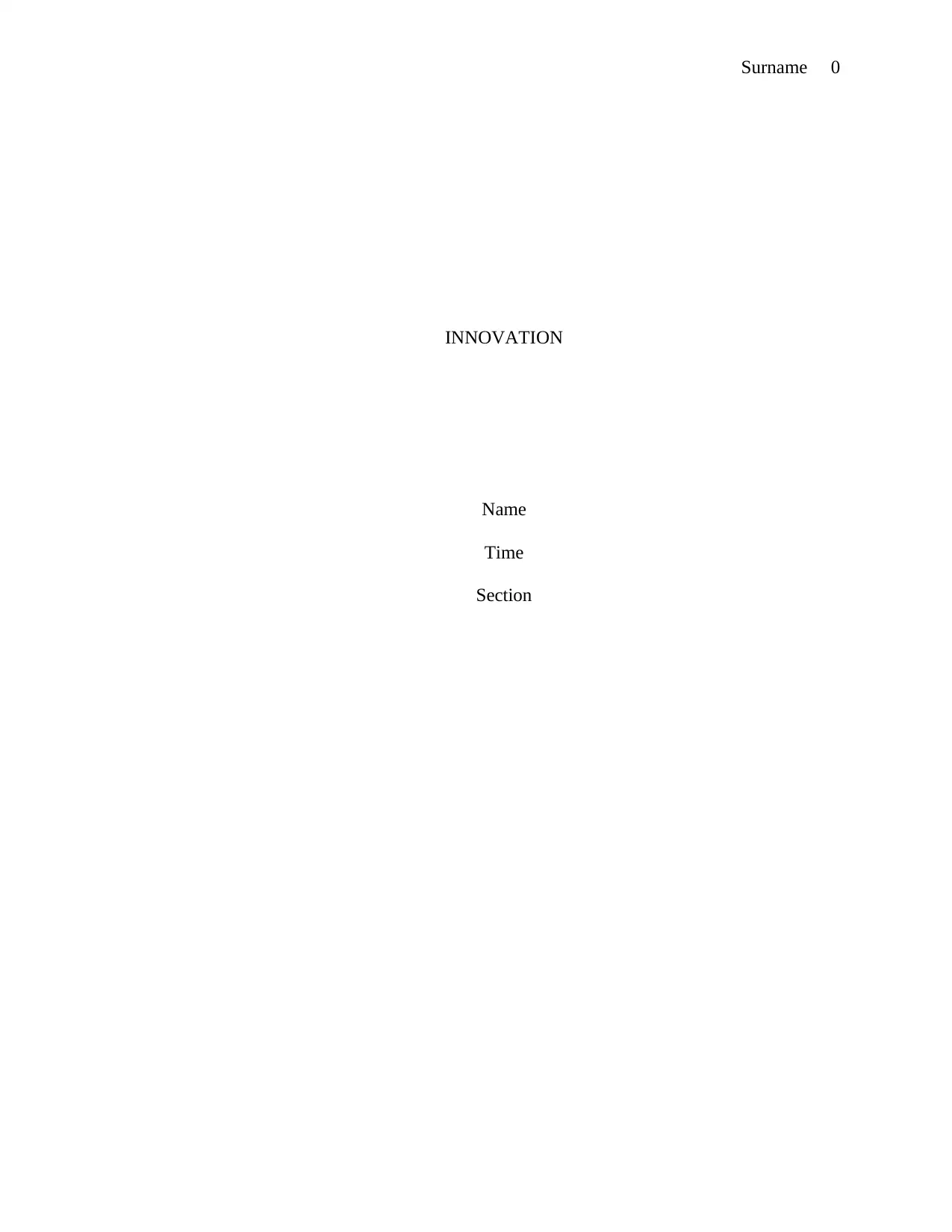
Surname 0
INNOVATION
Name
Time
Section
INNOVATION
Name
Time
Section
Paraphrase This Document
Need a fresh take? Get an instant paraphrase of this document with our AI Paraphraser
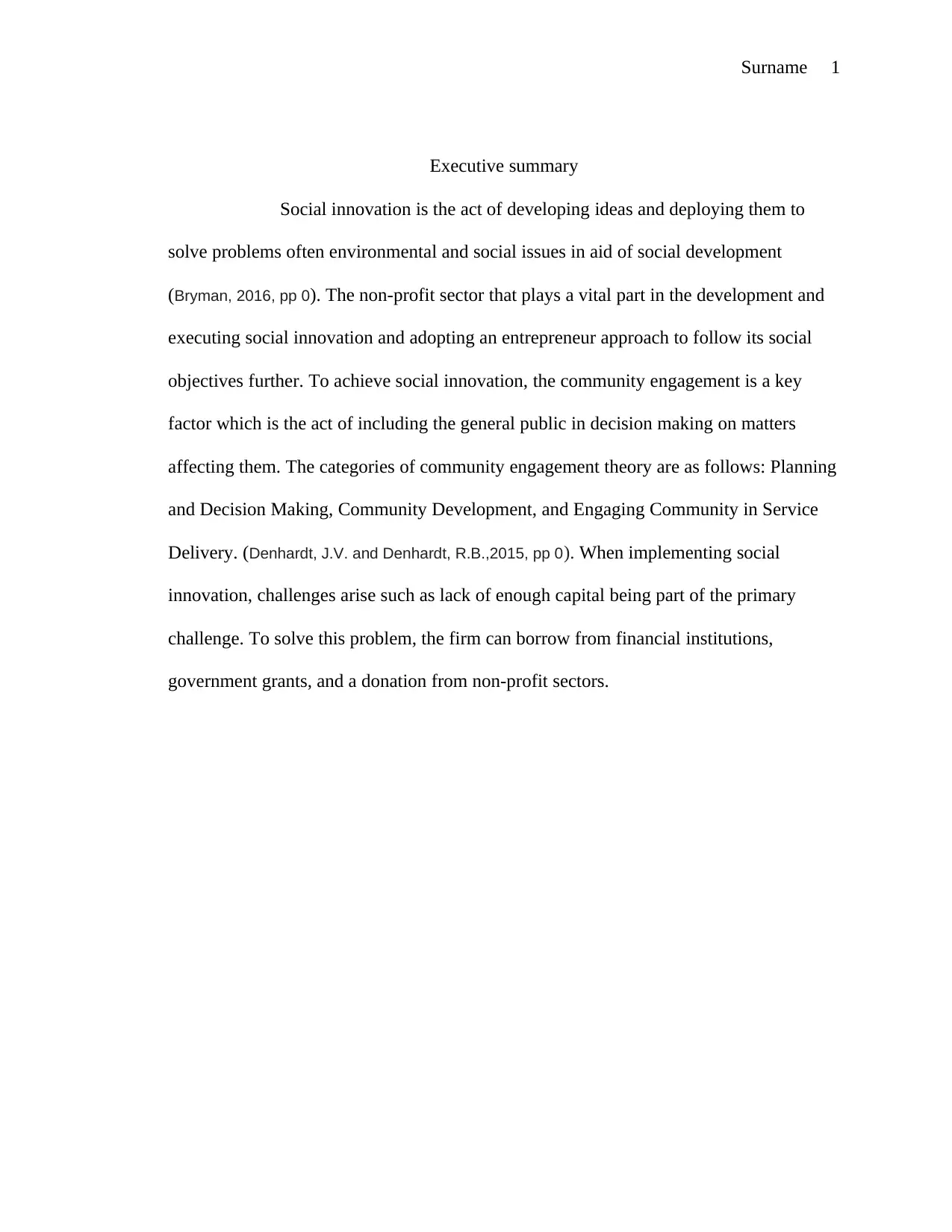
Surname 1
Executive summary
Social innovation is the act of developing ideas and deploying them to
solve problems often environmental and social issues in aid of social development
(Bryman, 2016, pp 0). The non-profit sector that plays a vital part in the development and
executing social innovation and adopting an entrepreneur approach to follow its social
objectives further. To achieve social innovation, the community engagement is a key
factor which is the act of including the general public in decision making on matters
affecting them. The categories of community engagement theory are as follows: Planning
and Decision Making, Community Development, and Engaging Community in Service
Delivery. (Denhardt, J.V. and Denhardt, R.B.,2015, pp 0). When implementing social
innovation, challenges arise such as lack of enough capital being part of the primary
challenge. To solve this problem, the firm can borrow from financial institutions,
government grants, and a donation from non-profit sectors.
Executive summary
Social innovation is the act of developing ideas and deploying them to
solve problems often environmental and social issues in aid of social development
(Bryman, 2016, pp 0). The non-profit sector that plays a vital part in the development and
executing social innovation and adopting an entrepreneur approach to follow its social
objectives further. To achieve social innovation, the community engagement is a key
factor which is the act of including the general public in decision making on matters
affecting them. The categories of community engagement theory are as follows: Planning
and Decision Making, Community Development, and Engaging Community in Service
Delivery. (Denhardt, J.V. and Denhardt, R.B.,2015, pp 0). When implementing social
innovation, challenges arise such as lack of enough capital being part of the primary
challenge. To solve this problem, the firm can borrow from financial institutions,
government grants, and a donation from non-profit sectors.
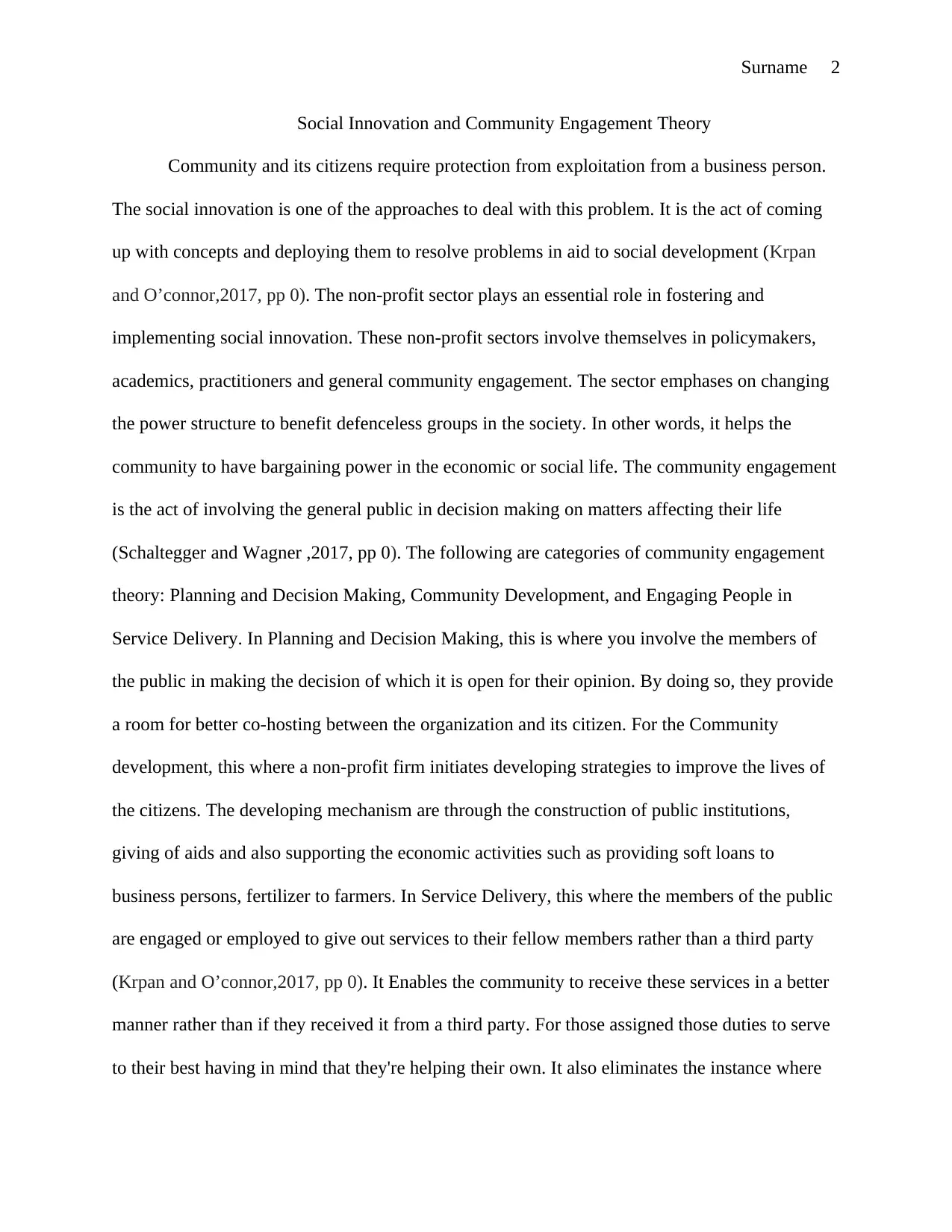
Surname 2
Social Innovation and Community Engagement Theory
Community and its citizens require protection from exploitation from a business person.
The social innovation is one of the approaches to deal with this problem. It is the act of coming
up with concepts and deploying them to resolve problems in aid to social development (Krpan
and O’connor,2017, pp 0). The non-profit sector plays an essential role in fostering and
implementing social innovation. These non-profit sectors involve themselves in policymakers,
academics, practitioners and general community engagement. The sector emphases on changing
the power structure to benefit defenceless groups in the society. In other words, it helps the
community to have bargaining power in the economic or social life. The community engagement
is the act of involving the general public in decision making on matters affecting their life
(Schaltegger and Wagner ,2017, pp 0). The following are categories of community engagement
theory: Planning and Decision Making, Community Development, and Engaging People in
Service Delivery. In Planning and Decision Making, this is where you involve the members of
the public in making the decision of which it is open for their opinion. By doing so, they provide
a room for better co-hosting between the organization and its citizen. For the Community
development, this where a non-profit firm initiates developing strategies to improve the lives of
the citizens. The developing mechanism are through the construction of public institutions,
giving of aids and also supporting the economic activities such as providing soft loans to
business persons, fertilizer to farmers. In Service Delivery, this where the members of the public
are engaged or employed to give out services to their fellow members rather than a third party
(Krpan and O’connor,2017, pp 0). It Enables the community to receive these services in a better
manner rather than if they received it from a third party. For those assigned those duties to serve
to their best having in mind that they're helping their own. It also eliminates the instance where
Social Innovation and Community Engagement Theory
Community and its citizens require protection from exploitation from a business person.
The social innovation is one of the approaches to deal with this problem. It is the act of coming
up with concepts and deploying them to resolve problems in aid to social development (Krpan
and O’connor,2017, pp 0). The non-profit sector plays an essential role in fostering and
implementing social innovation. These non-profit sectors involve themselves in policymakers,
academics, practitioners and general community engagement. The sector emphases on changing
the power structure to benefit defenceless groups in the society. In other words, it helps the
community to have bargaining power in the economic or social life. The community engagement
is the act of involving the general public in decision making on matters affecting their life
(Schaltegger and Wagner ,2017, pp 0). The following are categories of community engagement
theory: Planning and Decision Making, Community Development, and Engaging People in
Service Delivery. In Planning and Decision Making, this is where you involve the members of
the public in making the decision of which it is open for their opinion. By doing so, they provide
a room for better co-hosting between the organization and its citizen. For the Community
development, this where a non-profit firm initiates developing strategies to improve the lives of
the citizens. The developing mechanism are through the construction of public institutions,
giving of aids and also supporting the economic activities such as providing soft loans to
business persons, fertilizer to farmers. In Service Delivery, this where the members of the public
are engaged or employed to give out services to their fellow members rather than a third party
(Krpan and O’connor,2017, pp 0). It Enables the community to receive these services in a better
manner rather than if they received it from a third party. For those assigned those duties to serve
to their best having in mind that they're helping their own. It also eliminates the instance where
You're viewing a preview
Unlock full access by subscribing today!
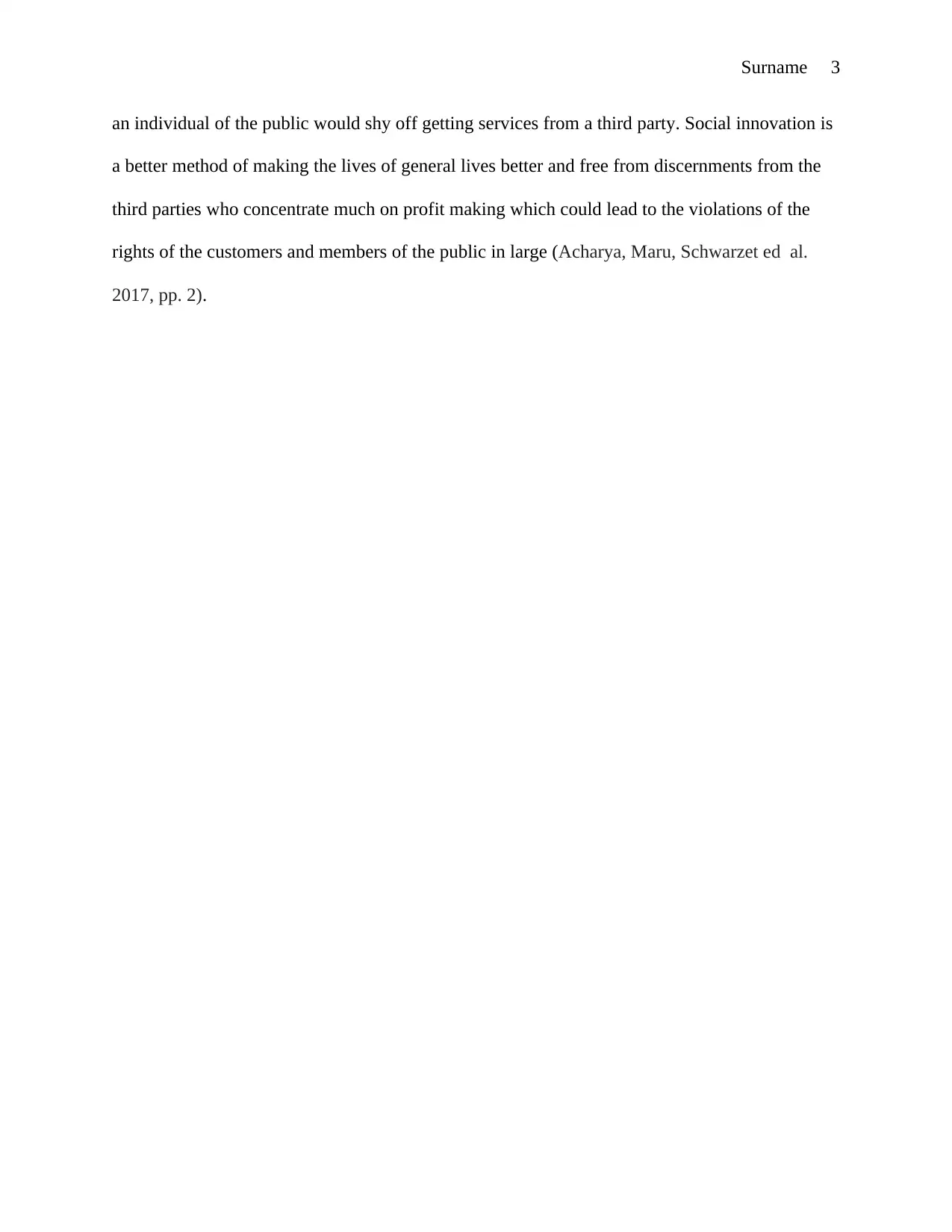
Surname 3
an individual of the public would shy off getting services from a third party. Social innovation is
a better method of making the lives of general lives better and free from discernments from the
third parties who concentrate much on profit making which could lead to the violations of the
rights of the customers and members of the public in large (Acharya, Maru, Schwarzet ed al.
2017, pp. 2).
an individual of the public would shy off getting services from a third party. Social innovation is
a better method of making the lives of general lives better and free from discernments from the
third parties who concentrate much on profit making which could lead to the violations of the
rights of the customers and members of the public in large (Acharya, Maru, Schwarzet ed al.
2017, pp. 2).
Paraphrase This Document
Need a fresh take? Get an instant paraphrase of this document with our AI Paraphraser
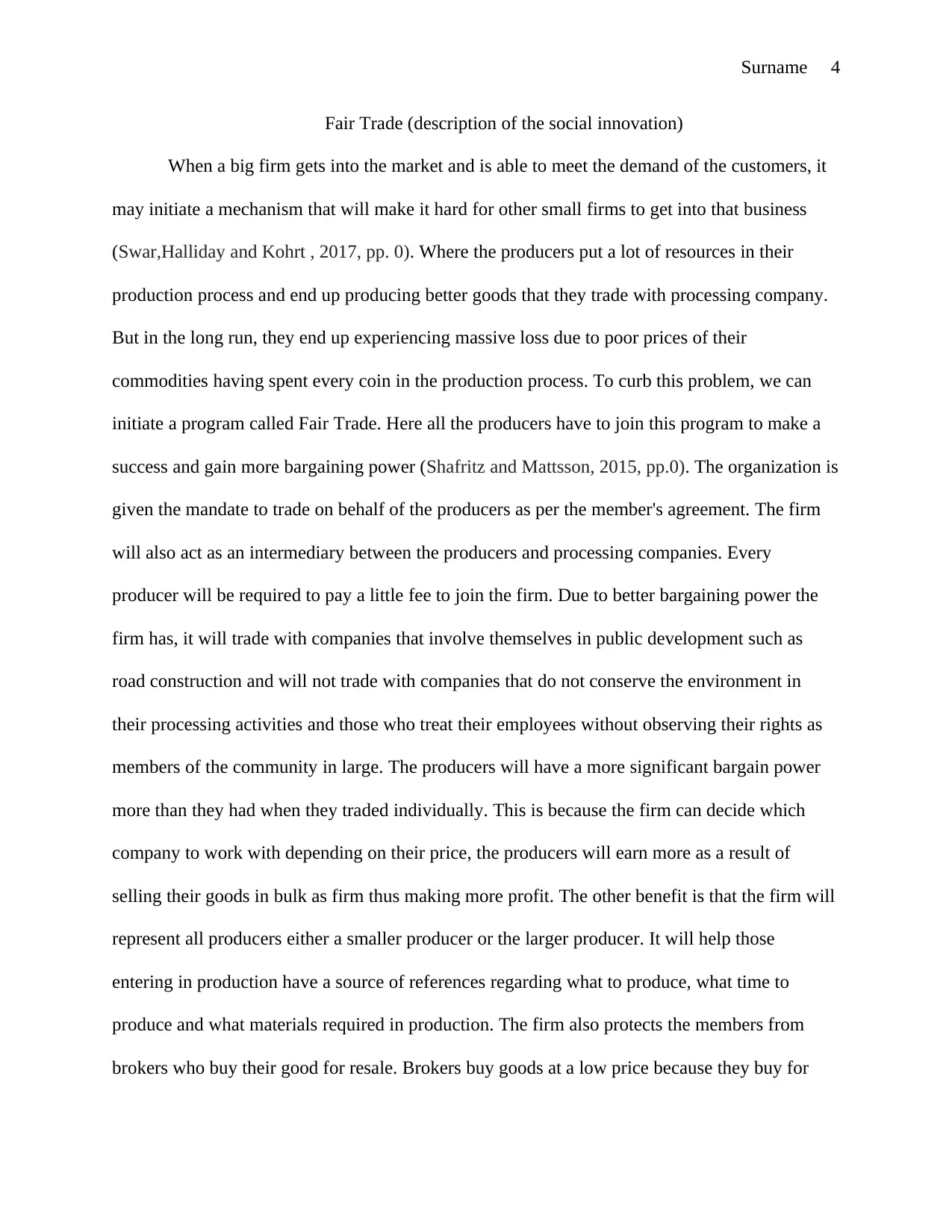
Surname 4
Fair Trade (description of the social innovation)
When a big firm gets into the market and is able to meet the demand of the customers, it
may initiate a mechanism that will make it hard for other small firms to get into that business
(Swar,Halliday and Kohrt , 2017, pp. 0). Where the producers put a lot of resources in their
production process and end up producing better goods that they trade with processing company.
But in the long run, they end up experiencing massive loss due to poor prices of their
commodities having spent every coin in the production process. To curb this problem, we can
initiate a program called Fair Trade. Here all the producers have to join this program to make a
success and gain more bargaining power (Shafritz and Mattsson, 2015, pp.0). The organization is
given the mandate to trade on behalf of the producers as per the member's agreement. The firm
will also act as an intermediary between the producers and processing companies. Every
producer will be required to pay a little fee to join the firm. Due to better bargaining power the
firm has, it will trade with companies that involve themselves in public development such as
road construction and will not trade with companies that do not conserve the environment in
their processing activities and those who treat their employees without observing their rights as
members of the community in large. The producers will have a more significant bargain power
more than they had when they traded individually. This is because the firm can decide which
company to work with depending on their price, the producers will earn more as a result of
selling their goods in bulk as firm thus making more profit. The other benefit is that the firm will
represent all producers either a smaller producer or the larger producer. It will help those
entering in production have a source of references regarding what to produce, what time to
produce and what materials required in production. The firm also protects the members from
brokers who buy their good for resale. Brokers buy goods at a low price because they buy for
Fair Trade (description of the social innovation)
When a big firm gets into the market and is able to meet the demand of the customers, it
may initiate a mechanism that will make it hard for other small firms to get into that business
(Swar,Halliday and Kohrt , 2017, pp. 0). Where the producers put a lot of resources in their
production process and end up producing better goods that they trade with processing company.
But in the long run, they end up experiencing massive loss due to poor prices of their
commodities having spent every coin in the production process. To curb this problem, we can
initiate a program called Fair Trade. Here all the producers have to join this program to make a
success and gain more bargaining power (Shafritz and Mattsson, 2015, pp.0). The organization is
given the mandate to trade on behalf of the producers as per the member's agreement. The firm
will also act as an intermediary between the producers and processing companies. Every
producer will be required to pay a little fee to join the firm. Due to better bargaining power the
firm has, it will trade with companies that involve themselves in public development such as
road construction and will not trade with companies that do not conserve the environment in
their processing activities and those who treat their employees without observing their rights as
members of the community in large. The producers will have a more significant bargain power
more than they had when they traded individually. This is because the firm can decide which
company to work with depending on their price, the producers will earn more as a result of
selling their goods in bulk as firm thus making more profit. The other benefit is that the firm will
represent all producers either a smaller producer or the larger producer. It will help those
entering in production have a source of references regarding what to produce, what time to
produce and what materials required in production. The firm also protects the members from
brokers who buy their good for resale. Brokers buy goods at a low price because they buy for
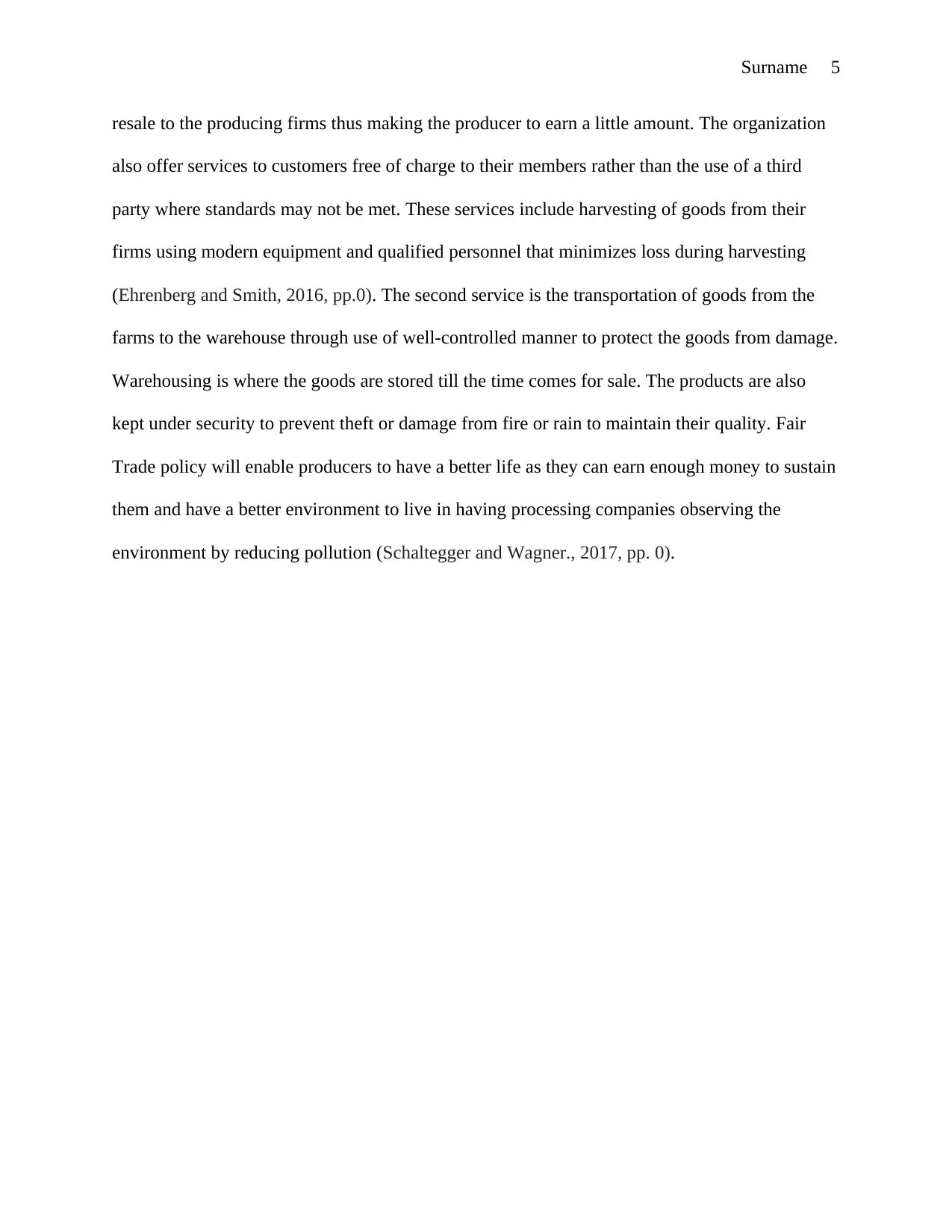
Surname 5
resale to the producing firms thus making the producer to earn a little amount. The organization
also offer services to customers free of charge to their members rather than the use of a third
party where standards may not be met. These services include harvesting of goods from their
firms using modern equipment and qualified personnel that minimizes loss during harvesting
(Ehrenberg and Smith, 2016, pp.0). The second service is the transportation of goods from the
farms to the warehouse through use of well-controlled manner to protect the goods from damage.
Warehousing is where the goods are stored till the time comes for sale. The products are also
kept under security to prevent theft or damage from fire or rain to maintain their quality. Fair
Trade policy will enable producers to have a better life as they can earn enough money to sustain
them and have a better environment to live in having processing companies observing the
environment by reducing pollution (Schaltegger and Wagner., 2017, pp. 0).
resale to the producing firms thus making the producer to earn a little amount. The organization
also offer services to customers free of charge to their members rather than the use of a third
party where standards may not be met. These services include harvesting of goods from their
firms using modern equipment and qualified personnel that minimizes loss during harvesting
(Ehrenberg and Smith, 2016, pp.0). The second service is the transportation of goods from the
farms to the warehouse through use of well-controlled manner to protect the goods from damage.
Warehousing is where the goods are stored till the time comes for sale. The products are also
kept under security to prevent theft or damage from fire or rain to maintain their quality. Fair
Trade policy will enable producers to have a better life as they can earn enough money to sustain
them and have a better environment to live in having processing companies observing the
environment by reducing pollution (Schaltegger and Wagner., 2017, pp. 0).
You're viewing a preview
Unlock full access by subscribing today!
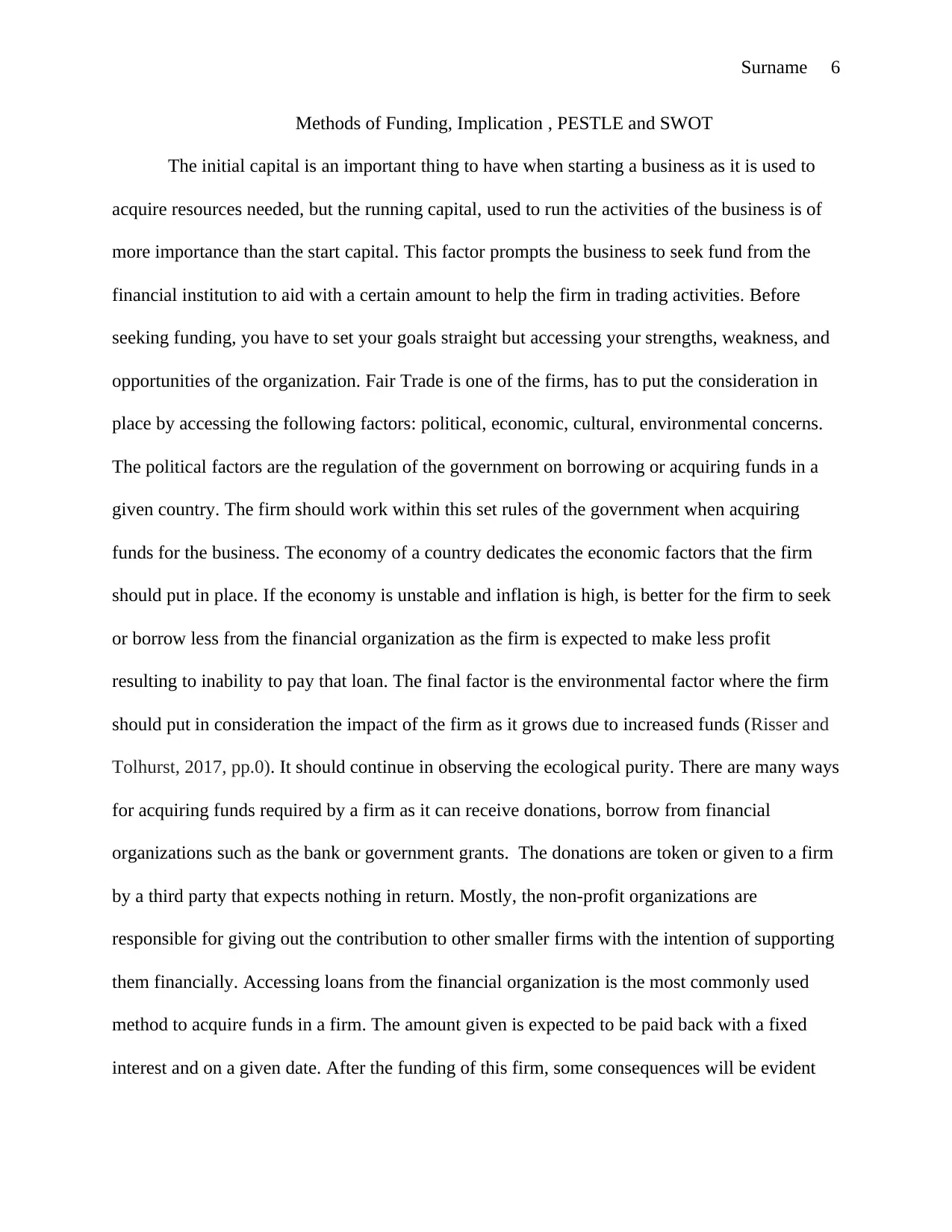
Surname 6
Methods of Funding, Implication , PESTLE and SWOT
The initial capital is an important thing to have when starting a business as it is used to
acquire resources needed, but the running capital, used to run the activities of the business is of
more importance than the start capital. This factor prompts the business to seek fund from the
financial institution to aid with a certain amount to help the firm in trading activities. Before
seeking funding, you have to set your goals straight but accessing your strengths, weakness, and
opportunities of the organization. Fair Trade is one of the firms, has to put the consideration in
place by accessing the following factors: political, economic, cultural, environmental concerns.
The political factors are the regulation of the government on borrowing or acquiring funds in a
given country. The firm should work within this set rules of the government when acquiring
funds for the business. The economy of a country dedicates the economic factors that the firm
should put in place. If the economy is unstable and inflation is high, is better for the firm to seek
or borrow less from the financial organization as the firm is expected to make less profit
resulting to inability to pay that loan. The final factor is the environmental factor where the firm
should put in consideration the impact of the firm as it grows due to increased funds (Risser and
Tolhurst, 2017, pp.0). It should continue in observing the ecological purity. There are many ways
for acquiring funds required by a firm as it can receive donations, borrow from financial
organizations such as the bank or government grants. The donations are token or given to a firm
by a third party that expects nothing in return. Mostly, the non-profit organizations are
responsible for giving out the contribution to other smaller firms with the intention of supporting
them financially. Accessing loans from the financial organization is the most commonly used
method to acquire funds in a firm. The amount given is expected to be paid back with a fixed
interest and on a given date. After the funding of this firm, some consequences will be evident
Methods of Funding, Implication , PESTLE and SWOT
The initial capital is an important thing to have when starting a business as it is used to
acquire resources needed, but the running capital, used to run the activities of the business is of
more importance than the start capital. This factor prompts the business to seek fund from the
financial institution to aid with a certain amount to help the firm in trading activities. Before
seeking funding, you have to set your goals straight but accessing your strengths, weakness, and
opportunities of the organization. Fair Trade is one of the firms, has to put the consideration in
place by accessing the following factors: political, economic, cultural, environmental concerns.
The political factors are the regulation of the government on borrowing or acquiring funds in a
given country. The firm should work within this set rules of the government when acquiring
funds for the business. The economy of a country dedicates the economic factors that the firm
should put in place. If the economy is unstable and inflation is high, is better for the firm to seek
or borrow less from the financial organization as the firm is expected to make less profit
resulting to inability to pay that loan. The final factor is the environmental factor where the firm
should put in consideration the impact of the firm as it grows due to increased funds (Risser and
Tolhurst, 2017, pp.0). It should continue in observing the ecological purity. There are many ways
for acquiring funds required by a firm as it can receive donations, borrow from financial
organizations such as the bank or government grants. The donations are token or given to a firm
by a third party that expects nothing in return. Mostly, the non-profit organizations are
responsible for giving out the contribution to other smaller firms with the intention of supporting
them financially. Accessing loans from the financial organization is the most commonly used
method to acquire funds in a firm. The amount given is expected to be paid back with a fixed
interest and on a given date. After the funding of this firm, some consequences will be evident
Paraphrase This Document
Need a fresh take? Get an instant paraphrase of this document with our AI Paraphraser
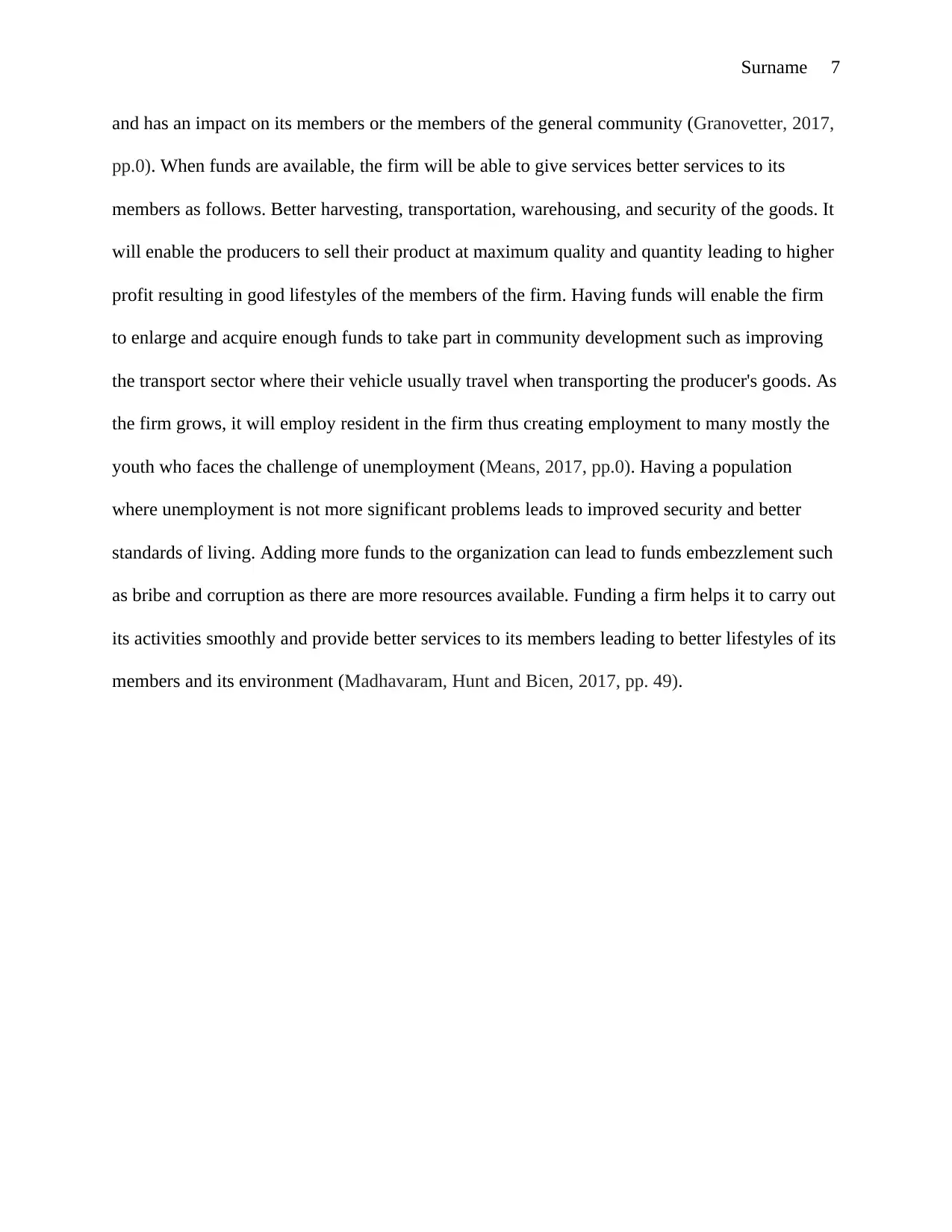
Surname 7
and has an impact on its members or the members of the general community (Granovetter, 2017,
pp.0). When funds are available, the firm will be able to give services better services to its
members as follows. Better harvesting, transportation, warehousing, and security of the goods. It
will enable the producers to sell their product at maximum quality and quantity leading to higher
profit resulting in good lifestyles of the members of the firm. Having funds will enable the firm
to enlarge and acquire enough funds to take part in community development such as improving
the transport sector where their vehicle usually travel when transporting the producer's goods. As
the firm grows, it will employ resident in the firm thus creating employment to many mostly the
youth who faces the challenge of unemployment (Means, 2017, pp.0). Having a population
where unemployment is not more significant problems leads to improved security and better
standards of living. Adding more funds to the organization can lead to funds embezzlement such
as bribe and corruption as there are more resources available. Funding a firm helps it to carry out
its activities smoothly and provide better services to its members leading to better lifestyles of its
members and its environment (Madhavaram, Hunt and Bicen, 2017, pp. 49).
and has an impact on its members or the members of the general community (Granovetter, 2017,
pp.0). When funds are available, the firm will be able to give services better services to its
members as follows. Better harvesting, transportation, warehousing, and security of the goods. It
will enable the producers to sell their product at maximum quality and quantity leading to higher
profit resulting in good lifestyles of the members of the firm. Having funds will enable the firm
to enlarge and acquire enough funds to take part in community development such as improving
the transport sector where their vehicle usually travel when transporting the producer's goods. As
the firm grows, it will employ resident in the firm thus creating employment to many mostly the
youth who faces the challenge of unemployment (Means, 2017, pp.0). Having a population
where unemployment is not more significant problems leads to improved security and better
standards of living. Adding more funds to the organization can lead to funds embezzlement such
as bribe and corruption as there are more resources available. Funding a firm helps it to carry out
its activities smoothly and provide better services to its members leading to better lifestyles of its
members and its environment (Madhavaram, Hunt and Bicen, 2017, pp. 49).
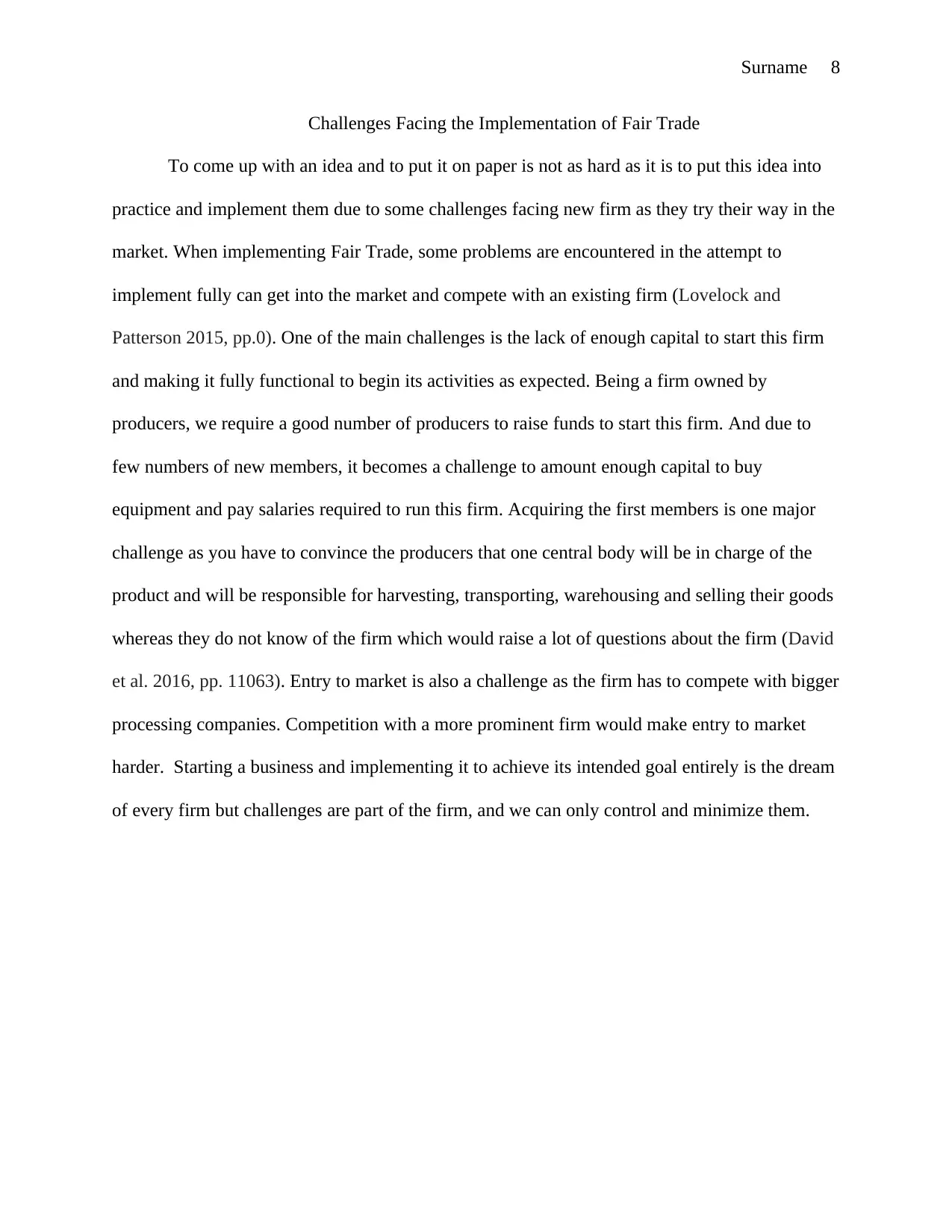
Surname 8
Challenges Facing the Implementation of Fair Trade
To come up with an idea and to put it on paper is not as hard as it is to put this idea into
practice and implement them due to some challenges facing new firm as they try their way in the
market. When implementing Fair Trade, some problems are encountered in the attempt to
implement fully can get into the market and compete with an existing firm (Lovelock and
Patterson 2015, pp.0). One of the main challenges is the lack of enough capital to start this firm
and making it fully functional to begin its activities as expected. Being a firm owned by
producers, we require a good number of producers to raise funds to start this firm. And due to
few numbers of new members, it becomes a challenge to amount enough capital to buy
equipment and pay salaries required to run this firm. Acquiring the first members is one major
challenge as you have to convince the producers that one central body will be in charge of the
product and will be responsible for harvesting, transporting, warehousing and selling their goods
whereas they do not know of the firm which would raise a lot of questions about the firm (David
et al. 2016, pp. 11063). Entry to market is also a challenge as the firm has to compete with bigger
processing companies. Competition with a more prominent firm would make entry to market
harder. Starting a business and implementing it to achieve its intended goal entirely is the dream
of every firm but challenges are part of the firm, and we can only control and minimize them.
Challenges Facing the Implementation of Fair Trade
To come up with an idea and to put it on paper is not as hard as it is to put this idea into
practice and implement them due to some challenges facing new firm as they try their way in the
market. When implementing Fair Trade, some problems are encountered in the attempt to
implement fully can get into the market and compete with an existing firm (Lovelock and
Patterson 2015, pp.0). One of the main challenges is the lack of enough capital to start this firm
and making it fully functional to begin its activities as expected. Being a firm owned by
producers, we require a good number of producers to raise funds to start this firm. And due to
few numbers of new members, it becomes a challenge to amount enough capital to buy
equipment and pay salaries required to run this firm. Acquiring the first members is one major
challenge as you have to convince the producers that one central body will be in charge of the
product and will be responsible for harvesting, transporting, warehousing and selling their goods
whereas they do not know of the firm which would raise a lot of questions about the firm (David
et al. 2016, pp. 11063). Entry to market is also a challenge as the firm has to compete with bigger
processing companies. Competition with a more prominent firm would make entry to market
harder. Starting a business and implementing it to achieve its intended goal entirely is the dream
of every firm but challenges are part of the firm, and we can only control and minimize them.
You're viewing a preview
Unlock full access by subscribing today!
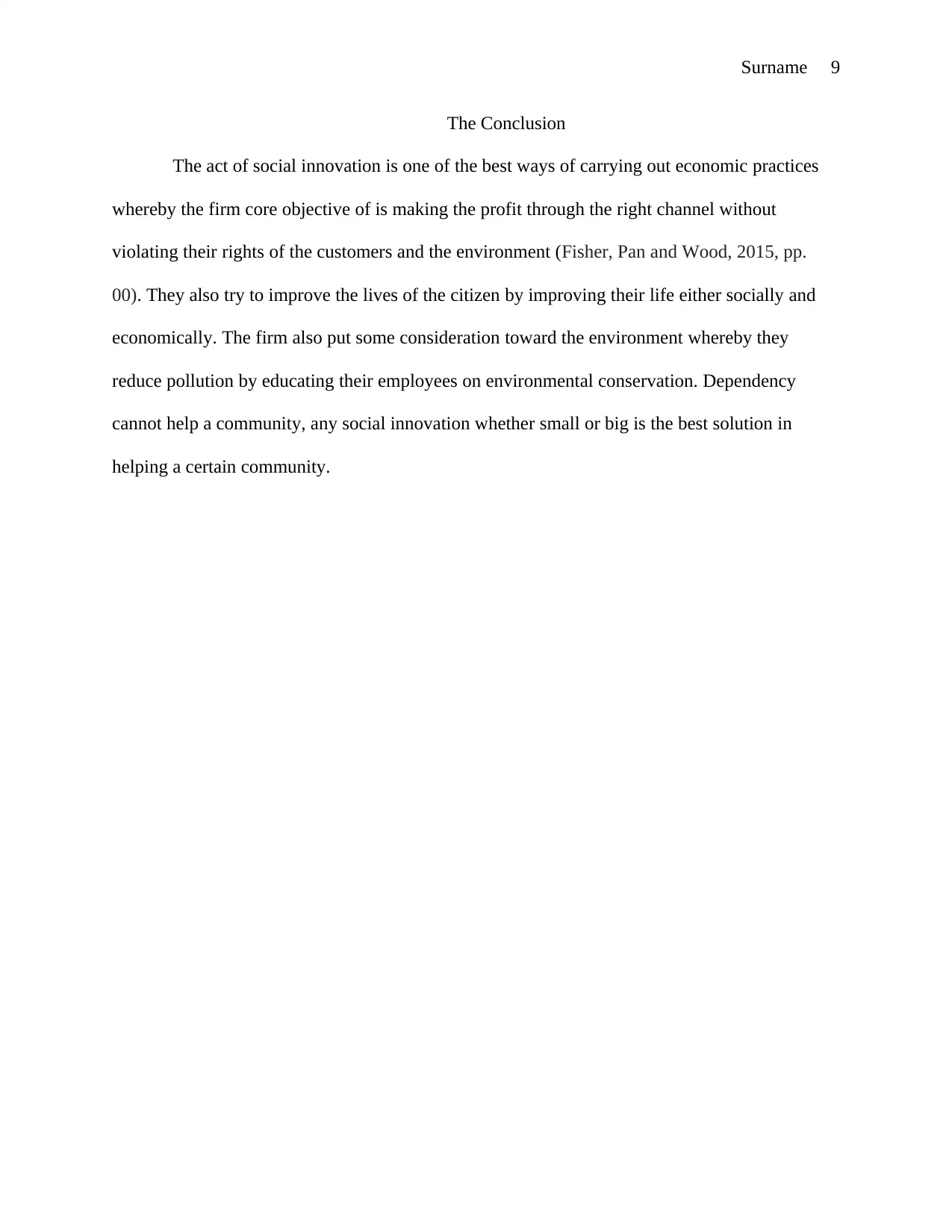
Surname 9
The Conclusion
The act of social innovation is one of the best ways of carrying out economic practices
whereby the firm core objective of is making the profit through the right channel without
violating their rights of the customers and the environment (Fisher, Pan and Wood, 2015, pp.
00). They also try to improve the lives of the citizen by improving their life either socially and
economically. The firm also put some consideration toward the environment whereby they
reduce pollution by educating their employees on environmental conservation. Dependency
cannot help a community, any social innovation whether small or big is the best solution in
helping a certain community.
The Conclusion
The act of social innovation is one of the best ways of carrying out economic practices
whereby the firm core objective of is making the profit through the right channel without
violating their rights of the customers and the environment (Fisher, Pan and Wood, 2015, pp.
00). They also try to improve the lives of the citizen by improving their life either socially and
economically. The firm also put some consideration toward the environment whereby they
reduce pollution by educating their employees on environmental conservation. Dependency
cannot help a community, any social innovation whether small or big is the best solution in
helping a certain community.
Paraphrase This Document
Need a fresh take? Get an instant paraphrase of this document with our AI Paraphraser
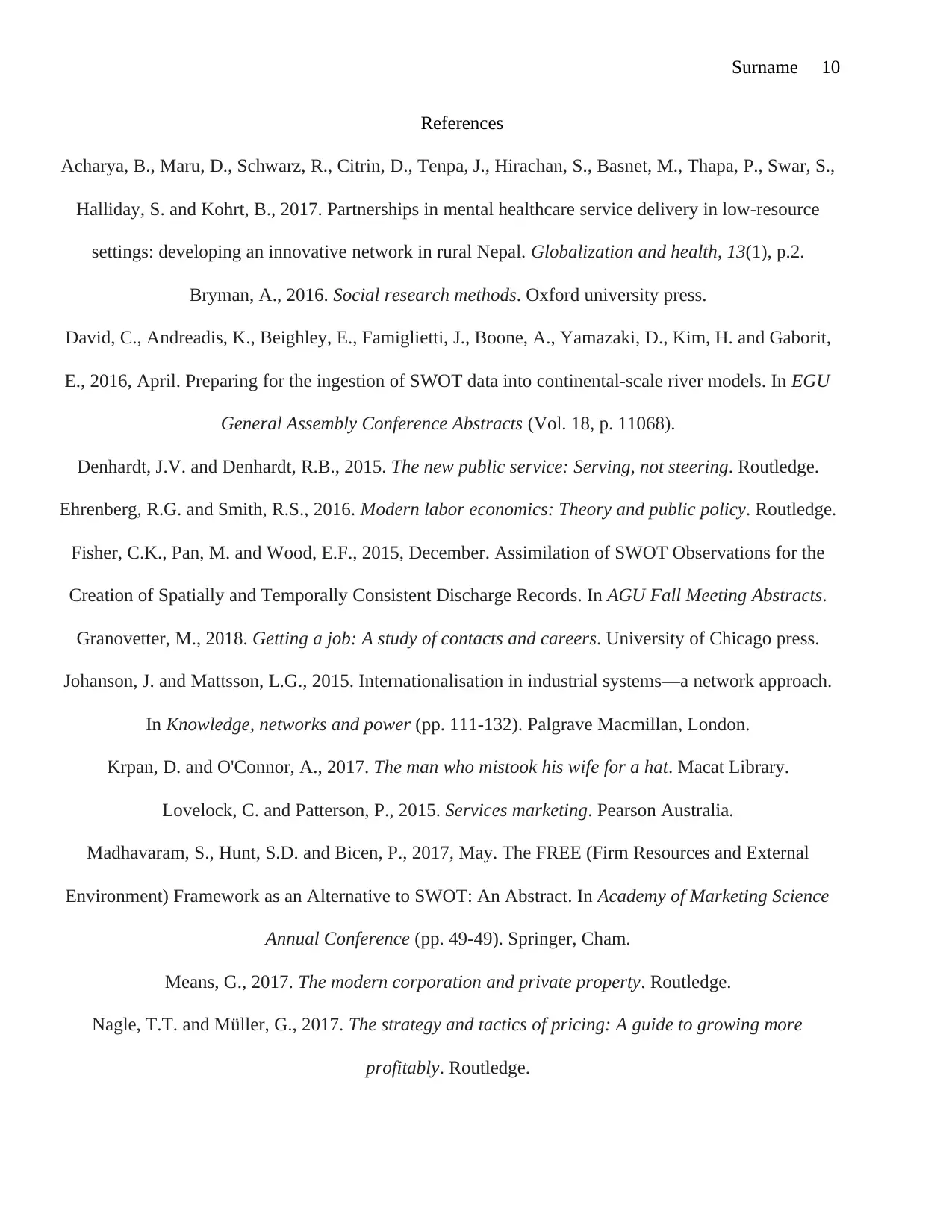
Surname 10
References
Acharya, B., Maru, D., Schwarz, R., Citrin, D., Tenpa, J., Hirachan, S., Basnet, M., Thapa, P., Swar, S.,
Halliday, S. and Kohrt, B., 2017. Partnerships in mental healthcare service delivery in low-resource
settings: developing an innovative network in rural Nepal. Globalization and health, 13(1), p.2.
Bryman, A., 2016. Social research methods. Oxford university press.
David, C., Andreadis, K., Beighley, E., Famiglietti, J., Boone, A., Yamazaki, D., Kim, H. and Gaborit,
E., 2016, April. Preparing for the ingestion of SWOT data into continental-scale river models. In EGU
General Assembly Conference Abstracts (Vol. 18, p. 11068).
Denhardt, J.V. and Denhardt, R.B., 2015. The new public service: Serving, not steering. Routledge.
Ehrenberg, R.G. and Smith, R.S., 2016. Modern labor economics: Theory and public policy. Routledge.
Fisher, C.K., Pan, M. and Wood, E.F., 2015, December. Assimilation of SWOT Observations for the
Creation of Spatially and Temporally Consistent Discharge Records. In AGU Fall Meeting Abstracts.
Granovetter, M., 2018. Getting a job: A study of contacts and careers. University of Chicago press.
Johanson, J. and Mattsson, L.G., 2015. Internationalisation in industrial systems—a network approach.
In Knowledge, networks and power (pp. 111-132). Palgrave Macmillan, London.
Krpan, D. and O'Connor, A., 2017. The man who mistook his wife for a hat. Macat Library.
Lovelock, C. and Patterson, P., 2015. Services marketing. Pearson Australia.
Madhavaram, S., Hunt, S.D. and Bicen, P., 2017, May. The FREE (Firm Resources and External
Environment) Framework as an Alternative to SWOT: An Abstract. In Academy of Marketing Science
Annual Conference (pp. 49-49). Springer, Cham.
Means, G., 2017. The modern corporation and private property. Routledge.
Nagle, T.T. and Müller, G., 2017. The strategy and tactics of pricing: A guide to growing more
profitably. Routledge.
References
Acharya, B., Maru, D., Schwarz, R., Citrin, D., Tenpa, J., Hirachan, S., Basnet, M., Thapa, P., Swar, S.,
Halliday, S. and Kohrt, B., 2017. Partnerships in mental healthcare service delivery in low-resource
settings: developing an innovative network in rural Nepal. Globalization and health, 13(1), p.2.
Bryman, A., 2016. Social research methods. Oxford university press.
David, C., Andreadis, K., Beighley, E., Famiglietti, J., Boone, A., Yamazaki, D., Kim, H. and Gaborit,
E., 2016, April. Preparing for the ingestion of SWOT data into continental-scale river models. In EGU
General Assembly Conference Abstracts (Vol. 18, p. 11068).
Denhardt, J.V. and Denhardt, R.B., 2015. The new public service: Serving, not steering. Routledge.
Ehrenberg, R.G. and Smith, R.S., 2016. Modern labor economics: Theory and public policy. Routledge.
Fisher, C.K., Pan, M. and Wood, E.F., 2015, December. Assimilation of SWOT Observations for the
Creation of Spatially and Temporally Consistent Discharge Records. In AGU Fall Meeting Abstracts.
Granovetter, M., 2018. Getting a job: A study of contacts and careers. University of Chicago press.
Johanson, J. and Mattsson, L.G., 2015. Internationalisation in industrial systems—a network approach.
In Knowledge, networks and power (pp. 111-132). Palgrave Macmillan, London.
Krpan, D. and O'Connor, A., 2017. The man who mistook his wife for a hat. Macat Library.
Lovelock, C. and Patterson, P., 2015. Services marketing. Pearson Australia.
Madhavaram, S., Hunt, S.D. and Bicen, P., 2017, May. The FREE (Firm Resources and External
Environment) Framework as an Alternative to SWOT: An Abstract. In Academy of Marketing Science
Annual Conference (pp. 49-49). Springer, Cham.
Means, G., 2017. The modern corporation and private property. Routledge.
Nagle, T.T. and Müller, G., 2017. The strategy and tactics of pricing: A guide to growing more
profitably. Routledge.
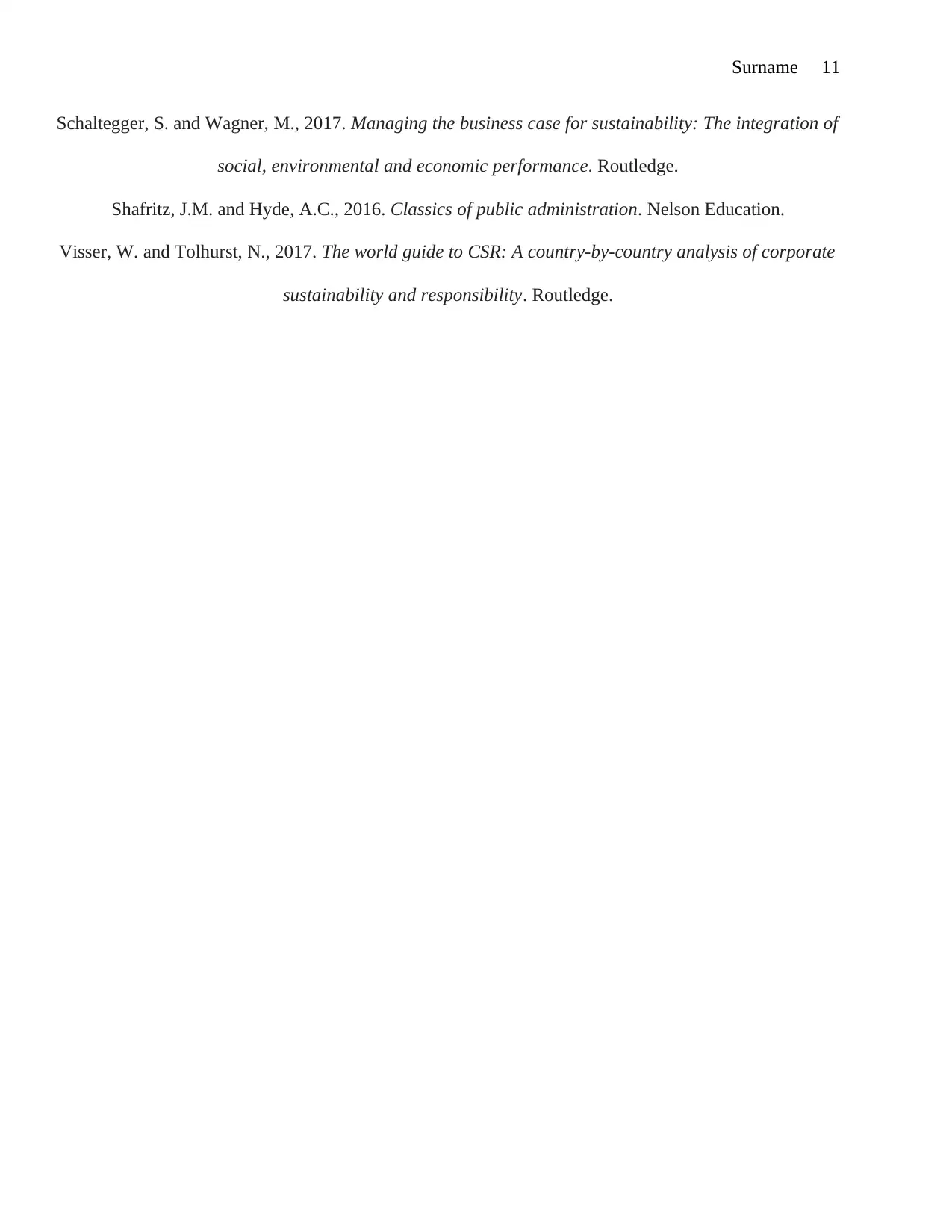
Surname 11
Schaltegger, S. and Wagner, M., 2017. Managing the business case for sustainability: The integration of
social, environmental and economic performance. Routledge.
Shafritz, J.M. and Hyde, A.C., 2016. Classics of public administration. Nelson Education.
Visser, W. and Tolhurst, N., 2017. The world guide to CSR: A country-by-country analysis of corporate
sustainability and responsibility. Routledge.
Schaltegger, S. and Wagner, M., 2017. Managing the business case for sustainability: The integration of
social, environmental and economic performance. Routledge.
Shafritz, J.M. and Hyde, A.C., 2016. Classics of public administration. Nelson Education.
Visser, W. and Tolhurst, N., 2017. The world guide to CSR: A country-by-country analysis of corporate
sustainability and responsibility. Routledge.
You're viewing a preview
Unlock full access by subscribing today!
1 out of 12
Related Documents
Your All-in-One AI-Powered Toolkit for Academic Success.
+13062052269
info@desklib.com
Available 24*7 on WhatsApp / Email
![[object Object]](/_next/static/media/star-bottom.7253800d.svg)
Unlock your academic potential
© 2024 | Zucol Services PVT LTD | All rights reserved.





